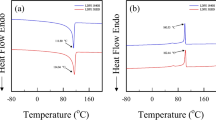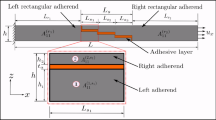Thermal oxidation is a major degradation mechanism for polymers and composites operating at high temperatures. Controlling the damage progression in oxidative environments is critical for enhancing the long-term durability of these materials. The surface oxidation of the material and the damage evolution in high-temperature polymer matrix composite materials (HTPMCs) are highly coupled mechanisms. In this article, three-dimensional, finite-element methods are used to simulate both oxidation layer and damage growth in polymers subjected to bending loads and laminated composites subjected to uniaxial tension. An oxygen diffusion–reaction model determines the changes in properties due to oxidation and chemical strains induced by oxidation. The damage growth is simulated using mesh-free extended finite-element techniques and suitable damage initiation laws. The damage evolution observed with simulations is seen to be consistent with experimental observations reported in the literature.










Similar content being viewed by others
References
G.A. Schoeppner, G.P. Tandon, and K.V. Pochiraju, Multi-Scale Modeling and Simulation of Composite Materials and Structures, ed. Y. Kwon, D.H. Allen, and R. Talreja (New York: Springer, 2007), p. 373.
K.V. Pochiraju and G.P. Tandon, Compos. A 40, 1931 (2009).
L. Martha, P.A. Waarzynek, and A.R. Ingraffea, Eng. Comput. 9, 63 (1993).
B.J. Carter, C.S. Chen, A.R. Ingraffea, and P.A. Wawrzynek, ICF9 (Sydney, Australia: Elsevier, 1997), p. 1923.
P.O. Bouchard, F. Bay, Y. Chastel, and I. Tovena, Comput. Methods Appl. Mech. Eng. 189, 723 (2000).
P.O. Bouchard, F. Bay, and Y. Chastel, Comput. Methods Appl. Mech. Eng. 192, 3887 (2002).
B. Patzak and M. Jirasek, J. Eng. Mech. 130, 720 (2004).
T. Belytschko, Y. Krongauz, D. Organ, M. Fleming, and P. Krysl, Comput. Methods Appl. Mech. Eng. 139, 3 (1996).
E.N. Dvorkin, A.M. Cuitino, and G. Gioia, Comput. Methods Appl. Mech. Eng. 90, 829 (1990).
M. Klisinski, K. Runesson, and S. Sture, J. Eng. Mech.-ASCE 117, 575 (1991).
J.C. Simo and J. Oliver, Fracture and Damage in Quasibrittle Structures, ed. Z.P. Bazant, Z. Bittnar, M. Jirasek, and J. Mazars (London, UK: E & FN Spon, 1994), p. 25.
T. Olofsson, M. Klisinski, and P. Neda, Computational Modeling of Concrete Structures, ed. H. Mang, N. Bicanic, and R. de Borst (Swansea, U.K.: Pineridge, 1998), p. 373.
J. Oliver, Int. J. Numer. Meth. Eng. 39, 3575 (1996).
J.M. Melenk and I. Babuska, Comput. Methods Appl. Mech. Eng. 139, 289 (1996).
N. Moes, J. Dolbow, and T. Belytschko, Int. J. Numer. Meth. Eng. 46, 131 (1999).
T. Belytschko and T. Black, Int. J. Numer. Meth. Eng. 45, 601 (1999).
J. Milan and T. Zimmermann, Int. J. Numer. Meth. Eng. 50, 1269 (2001).
J. Milan and T. Zimmermann, Int. J. Numer. Meth. Eng. 50, 1291 (2001).
E. Budyn, G. Zi, N. Moes, and T. Belytschko, Int. J. Numer. Meth. Eng. 61, 1741 (2004).
G.P. Tandon, K.V. Pochiraju, and G.A. Schoeppner, Polym. Degrad. Stabil. 91, 1861 (2006).
K.V. Pochiraju and G.P. Tandon, J. Eng. Mater.-T. ASME 128, 107 (2006).
K.V. Pochiraju, G.P. Tandon, and G. Schoeppner, Mech. Time-Depend. Mater. 12, 45 (2008).
G.P. Tandon and K.V. Pochiraju, J. Compos. Mater. 45, 415 (2001).
N.S. Bakhvalov and G. Panasenko, Mathematical Problems in Mechanics of Composite Materials (New York: Springer, 1989).
Z. Hashin and A. Rotem, J. Compos. Mater. 7, 448 (1973).
Z. Hashin, J. Appl. Mech. 47, 329 (1980).
G.P. Tandon, Long-Term Durability of Polymeric Matrix Composites, ed. K.V. Pochiraju, G.P. Tandon, and G.A. Schoeppner (New York: Springer, 2012), p. 345.
Author information
Authors and Affiliations
Corresponding author
Rights and permissions
About this article
Cite this article
An, N., Pochiraju, K. Modeling Damage Growth in Oxidized High-Temperature Polymeric Composites. JOM 65, 246–255 (2013). https://doi.org/10.1007/s11837-012-0514-y
Received:
Accepted:
Published:
Issue Date:
DOI: https://doi.org/10.1007/s11837-012-0514-y




